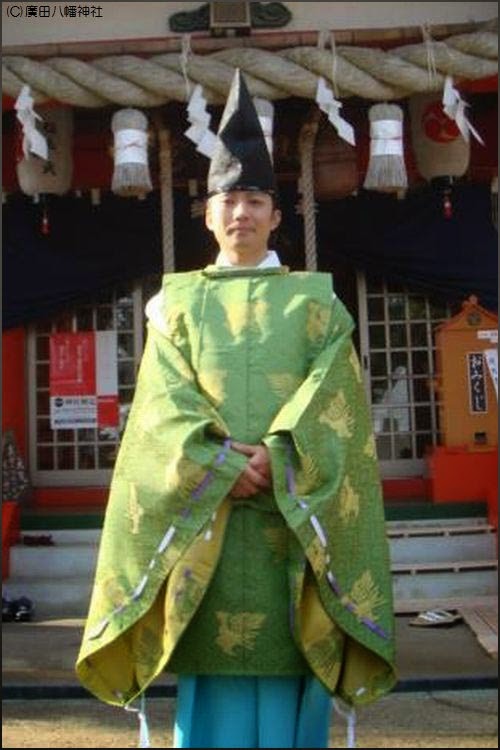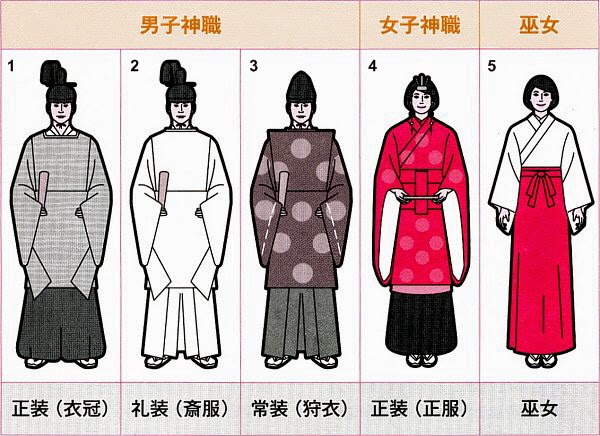[ . BACK to DARUMA MUSEUM TOP . ]
:::::::::::::::::::::::::::::::::::::::::::::::::::::::::::::::::::::::::::::::::::::::::::::::::::::::::::::::::::::::::::::::::::::::::::::::::::::::::::::::::::::::::::::::::::::
kannushi 神主 Shinto priest
![]()
- quote
saikan 斎館
Also kandachi神館, shinkan神館.
1 At Ise Jinguu 伊勢神宮, saikan refers to those who serve the shrine: the master of religious ceremonies, saishu祭主; the chief priest, daiguuji大宮司; the assistant priests, shouguuji少宮司; lower rank priests, negi禰宜; assistants to lower rank priests, gonnegi権禰宜; and shrine administrators, guushou宮掌.
2 A person involved in religious duties at a Shinto shrine. Also kannushi神主, shinshoku神職.
3 A purification hall where all priests, and at Ise Jinguu the head priestess as well, purify themselves prior to participating in any ceremony.
- source : JAANUS
. Shrine, Shinto Shrine (jinja 神社) .
- Introduction -
:::::::::::::::::::::::::::::::::::::::::::::::::::::::::::::::::::::::::::::::::::::::::::::::::::::::::::::::::::::::::::::::::::::::::::::::::::::::::::::::::::::::::::::::::::::
- quote
Becoming a Shintō Priest or Priestess
Titles - Roles of Men & Women Serving Shrines
To work officially as a priest in modern Japan, individuals must pass examinations given by the Association of Shintō Shrines (Jinja Honchō 神社本庁) -- these tests are open to both men and women who want to become Shintō priests. But until modern times, there was no standardized certification or qualification system.
snip
Other Important Terms for Those Serving Shintō Shrines
Hafuri祝. A term for Shintō priests, usually a rank beneath kannushi and negi. (Kokugakuin)
Hafuribe祝部. One type of priest established under the ancient ritsuryō system. (Kokugakuin)
Kandachi 神館; place for Shintō purification rites, as well as a place for priests to go into seclusion for a set amount of time; also known as Saikan 斎館 or Shinkan 神館.
Kannushi神主; generic term for shrine priests and those who perform religious duties at Shintō shrines; also known as Saikan 斎館 or Shinshoku 神職. Says the Kokugakuin University Encyclopedia of Shintō: "The kannushi was a mediator (nakatorimachi 仲執り持ち or 仲取持ち) between kami and humans, and served the kami on behalf of humanity. Sometimes the kannushi played the role of the kami or even acted as a kami to transmit the will of the kami to humanity."
Nai-Shōten 内掌典. Female attendants who assist the emperor in the performance of the annual Niinamesai ceremony 新嘗祭 (rice tasting ceremony), when the emperor offers the first fruits of each year's rice harvest to the gods and then eats a little himself.
Saikan斎館; one who performs religious duties at Shintō shrines; aka Kannushi 神主 or Shinshoku 神職. Saikan also refers to a purification hall where priests purify themselves prior to participating in ceremonies. At Ise Jingū, the head priestess as well undergoes purification in the Saikan.
Shashi社司. One who performs religious duties at higher ranking Shintō shrines.
Shashō社掌. Deputy priest, one rank below Shashi.
Shikan祠官. Priest at low-level village and hamlet shrines; those serving so-called “people’s shrines” (Minsha 民社)
Shinkan神館; see entry for Kandachi.
Shinkan神官; general term for Shintō priest.
Shinshoku神職; performs religious duties at Shintō shrines; aka Kannushi 神主 or Saikan 斎館.
Shishō祠掌. Priest at low-level village and hamlet shrines; those serving so-called “people’s shrines” (Minsha 民社)
Shōten掌典. Male clergy who assist the emperor in the performance of the annual Niinamesai ceremony 新嘗祭 (rice tasting ceremony).
![]()
Shintō Attire Among Clergy
The robes worn today by Shintō priests and priestesses are reportedly derived from gowns worn by the court and nobility in the Heian period (794 to 1185).
- more details and further LINKS
- source : Mark Schumacher
:::::::::::::::::::::::::::::::::::::::::::::::::::::::::::::::::::::::::::::::::::::::::::::::::::::::::::::::::::::::::::::::::::::::::::::::::::::::::::::::::::::::::::::::::::::
- quote
How to Become a Shinto Priest
Shintoism is the original faith of the indigenous Japanese, involving the worship of various Gods, Spirits and demons called Kami.
![]()
Shintoism is rare outside Japan though it is gaining popularity outside Japan in some countries. For those who wish to devote themselves to Shintoism and become priests, here is a guide.
- source : www.wikihow.com
- Reference : English
. Shrine, Shinto Shrine (jinja 神社) - Introduction .
:::::::::::::::::::::::::::::::::::::::::::::::::::::::::::::::::::::::::::::::::::::::::::::::::::::::::::::::::::::::::::::::::::::::::::::::::::::::::::::::::::::::::::::::::::::
- - - - - H A I K U - - - - -
宮一つ神主一人大吹雪
miya hitotsu kannushi hitori daifubuki
just one shrine
just one Shinto priest
super blizzard
Muramatsu Azami 村松紅花
- - - - - More haiku about the Shinto priests
- source : HAIKUreikuDB
:::::::::::::::::::::::::::::::::::::::::::::::::::::::::::::::::::::::::::::::::::::::::::::::::::::::::::::::::::::::::::::::::::::::::::::::::::::::::::::::::::::::::::::::::::::
[ . BACK to DARUMA MUSEUM TOP . ]
[ . BACK to WORLDKIGO . TOP . ]
:::::::::::::::::::::::::::::::::::::::::::::::::::::::::::::::::::::::::::::::::::::::::::::::::::::::::::::::::::::::::::::::::::::::::::::::::::::::::::::::::::::::::::::::::::::
:::::::::::::::::::::::::::::::::::::::::::::::::::::::::::::::::::::::::::::::::::::::::::::::::::::::::::::::::::::::::::::::::::::::::::::::::::::::::::::::::::::::::::::::::::::
kannushi 神主 Shinto priest

- quote
saikan 斎館
Also kandachi神館, shinkan神館.
1 At Ise Jinguu 伊勢神宮, saikan refers to those who serve the shrine: the master of religious ceremonies, saishu祭主; the chief priest, daiguuji大宮司; the assistant priests, shouguuji少宮司; lower rank priests, negi禰宜; assistants to lower rank priests, gonnegi権禰宜; and shrine administrators, guushou宮掌.
2 A person involved in religious duties at a Shinto shrine. Also kannushi神主, shinshoku神職.
3 A purification hall where all priests, and at Ise Jinguu the head priestess as well, purify themselves prior to participating in any ceremony.
- source : JAANUS
. Shrine, Shinto Shrine (jinja 神社) .
- Introduction -
:::::::::::::::::::::::::::::::::::::::::::::::::::::::::::::::::::::::::::::::::::::::::::::::::::::::::::::::::::::::::::::::::::::::::::::::::::::::::::::::::::::::::::::::::::::
- quote
Becoming a Shintō Priest or Priestess
Titles - Roles of Men & Women Serving Shrines
To work officially as a priest in modern Japan, individuals must pass examinations given by the Association of Shintō Shrines (Jinja Honchō 神社本庁) -- these tests are open to both men and women who want to become Shintō priests. But until modern times, there was no standardized certification or qualification system.
snip
Other Important Terms for Those Serving Shintō Shrines
Hafuri祝. A term for Shintō priests, usually a rank beneath kannushi and negi. (Kokugakuin)
Hafuribe祝部. One type of priest established under the ancient ritsuryō system. (Kokugakuin)
Kandachi 神館; place for Shintō purification rites, as well as a place for priests to go into seclusion for a set amount of time; also known as Saikan 斎館 or Shinkan 神館.
Kannushi神主; generic term for shrine priests and those who perform religious duties at Shintō shrines; also known as Saikan 斎館 or Shinshoku 神職. Says the Kokugakuin University Encyclopedia of Shintō: "The kannushi was a mediator (nakatorimachi 仲執り持ち or 仲取持ち) between kami and humans, and served the kami on behalf of humanity. Sometimes the kannushi played the role of the kami or even acted as a kami to transmit the will of the kami to humanity."
Nai-Shōten 内掌典. Female attendants who assist the emperor in the performance of the annual Niinamesai ceremony 新嘗祭 (rice tasting ceremony), when the emperor offers the first fruits of each year's rice harvest to the gods and then eats a little himself.
Saikan斎館; one who performs religious duties at Shintō shrines; aka Kannushi 神主 or Shinshoku 神職. Saikan also refers to a purification hall where priests purify themselves prior to participating in ceremonies. At Ise Jingū, the head priestess as well undergoes purification in the Saikan.
Shashi社司. One who performs religious duties at higher ranking Shintō shrines.
Shashō社掌. Deputy priest, one rank below Shashi.
Shikan祠官. Priest at low-level village and hamlet shrines; those serving so-called “people’s shrines” (Minsha 民社)
Shinkan神館; see entry for Kandachi.
Shinkan神官; general term for Shintō priest.
Shinshoku神職; performs religious duties at Shintō shrines; aka Kannushi 神主 or Saikan 斎館.
Shishō祠掌. Priest at low-level village and hamlet shrines; those serving so-called “people’s shrines” (Minsha 民社)
Shōten掌典. Male clergy who assist the emperor in the performance of the annual Niinamesai ceremony 新嘗祭 (rice tasting ceremony).

Shintō Attire Among Clergy
The robes worn today by Shintō priests and priestesses are reportedly derived from gowns worn by the court and nobility in the Heian period (794 to 1185).
- more details and further LINKS
- source : Mark Schumacher
:::::::::::::::::::::::::::::::::::::::::::::::::::::::::::::::::::::::::::::::::::::::::::::::::::::::::::::::::::::::::::::::::::::::::::::::::::::::::::::::::::::::::::::::::::::
- quote
How to Become a Shinto Priest
Shintoism is the original faith of the indigenous Japanese, involving the worship of various Gods, Spirits and demons called Kami.

Shintoism is rare outside Japan though it is gaining popularity outside Japan in some countries. For those who wish to devote themselves to Shintoism and become priests, here is a guide.
- source : www.wikihow.com
- Reference : English
. Shrine, Shinto Shrine (jinja 神社) - Introduction .
:::::::::::::::::::::::::::::::::::::::::::::::::::::::::::::::::::::::::::::::::::::::::::::::::::::::::::::::::::::::::::::::::::::::::::::::::::::::::::::::::::::::::::::::::::::
- - - - - H A I K U - - - - -
宮一つ神主一人大吹雪
miya hitotsu kannushi hitori daifubuki
just one shrine
just one Shinto priest
super blizzard
Muramatsu Azami 村松紅花
- - - - - More haiku about the Shinto priests
- source : HAIKUreikuDB
:::::::::::::::::::::::::::::::::::::::::::::::::::::::::::::::::::::::::::::::::::::::::::::::::::::::::::::::::::::::::::::::::::::::::::::::::::::::::::::::::::::::::::::::::::::
[ . BACK to DARUMA MUSEUM TOP . ]
[ . BACK to WORLDKIGO . TOP . ]
:::::::::::::::::::::::::::::::::::::::::::::::::::::::::::::::::::::::::::::::::::::::::::::::::::::::::::::::::::::::::::::::::::::::::::::::::::::::::::::::::::::::::::::::::::::